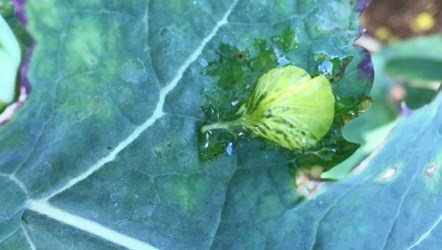- Home
- Sclerotinia infection risk alerts (forecast) for oilseed rape
Sclerotinia infection risk alerts (forecast) for oilseed rape
Use this tool to understand sclerotinia infection risk and target control.
 AHDB
AHDB
Sclerotinia stem rot is usually the main disease to consider during the flowering stages of oilseed rape. Although the infection cycle of the pathogen is complex, a good understanding of the three main risk factors – the presence of inoculum (spores), weather (warm and humid conditions), and crops in flower – will help you target control.
This interactive dashboard highlights when weather conditions are conducive for infection at over one hundred locations.
Green circles indicate low infection risk.
Page content in the tool
<1 of 3> Tool home page (includes links to all other pages).
<2 of 3> Infection risk alerts for the current season (2024) - default view.
<3 of 3> Numbers of Sclerotinia sclerotiorum spores per cubic metre of air sampled per day in spore traps.
About the sclerotinia infection risk alerts
How to use the alerts (video)
Weather and infection risk
If spores are present, conducive weather is required for infection to occur.
> Based on observed (past 24 hours) and forecast (next 72 hours) weather data, the interactive maps track the period of time that relative humidity (RH) and air temperatures are at or above threshold (80% and 7°C, respectively).
> If these thresholds are exceeded for 23 continuous hours (the time needed in order for sclerotinia to infect the crop), a weather-based infection alert is issued at the corresponding site (dark blue circle). Near misses are also highlighted (light blue circles). Where infection risk is low, this is shown (green circles).
Click on a circle (any colour) to show an hour-by-hour chart of the sclerotinia infection risk for that site.
Sclerotinia control products are protectants and should be applied prior to infection (before circles turn blue).
Forecast forensics
An overview of the 2021 season
Our weather-based sclerotinia infection risk alerts support decisions. When thresholds for temperature and humidity are met, a risk-alert is triggered. However, forecast weather data is not always accurate.
Here we analyse how good the predictions were during the 2021 season, in relation to risk alerts.
The 2021 risk period was relatively cool, which delayed flowering and extended the flowering period. It also resulted in a relatively low number of weather-based infection risk alerts and, generally, low spore levels.
Our analysis shows that forecast alerts were highly (91.5%) accurate, when compared to actual weather during the period 15 March to 23 June 2021.
Differences tend to be due to relative humidity (which is harder to forecast, due to localised showers and local factors) rather than temperature, and this is particularly true in costal locations.
| 91.5% Correct alerts | Forecast | ||
|---|---|---|---|
| Days with alert | Days without alert | ||
| Observed |
Days with alert | 1,336 true positives | 724 false negatives |
| Days without alert | 464 false positives | 11,000 true negatives | |
Spores and petal fall
Light rain during the petal-fall period increases petal stick. From infected petals, spores can germinate and infect the crop (providing weather is conducive). However, heavy downpours can actually reduce infection risk, reducing the airborne inoculum and washing petals straight to the ground.
The relatively cool weather over most of the winter and spring resulted in low levels of spores recorded in the AHDB-funded network of six spore traps. The wetter and milder May weather saw inoculum levels increase across the month. The results are similar to those revealed by ADAS petal tests. These reported:
- Zero-to-moderate levels during the early flowering period
- A decline through the mid-flowering period
- Moderate inoculum levels in the late-flowering period
Spray programmes
Fungicides targeted at sclerotinia must be applied ahead of infection (as protectants). A spray normally provides around 3 weeks protection. The 2021 season highlighted the value of the sclerotinia risk alert tool. With risk low for many through the early flowering stage, there was an opportunity to delay treatment and, where applied, reduce the requirement for a second treatment. However, the protracted flowering period in many crops – due to cooler conditions – meant a second spray will have been required in some crops, if weather conditions triggered an alert.
Further information
Sclerotinia stem rot in oilseed rape
Complete guide to oilseed rape growth stages
Sclerotinia risk live-reporting system for oilseed rape (research behind the risk alerts)

